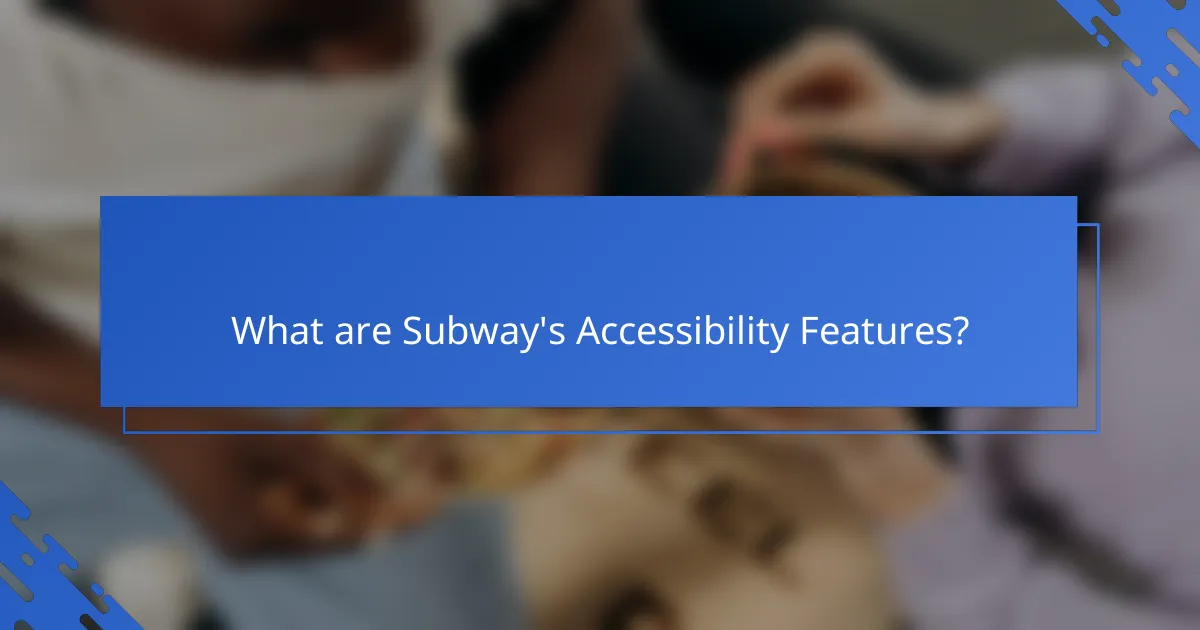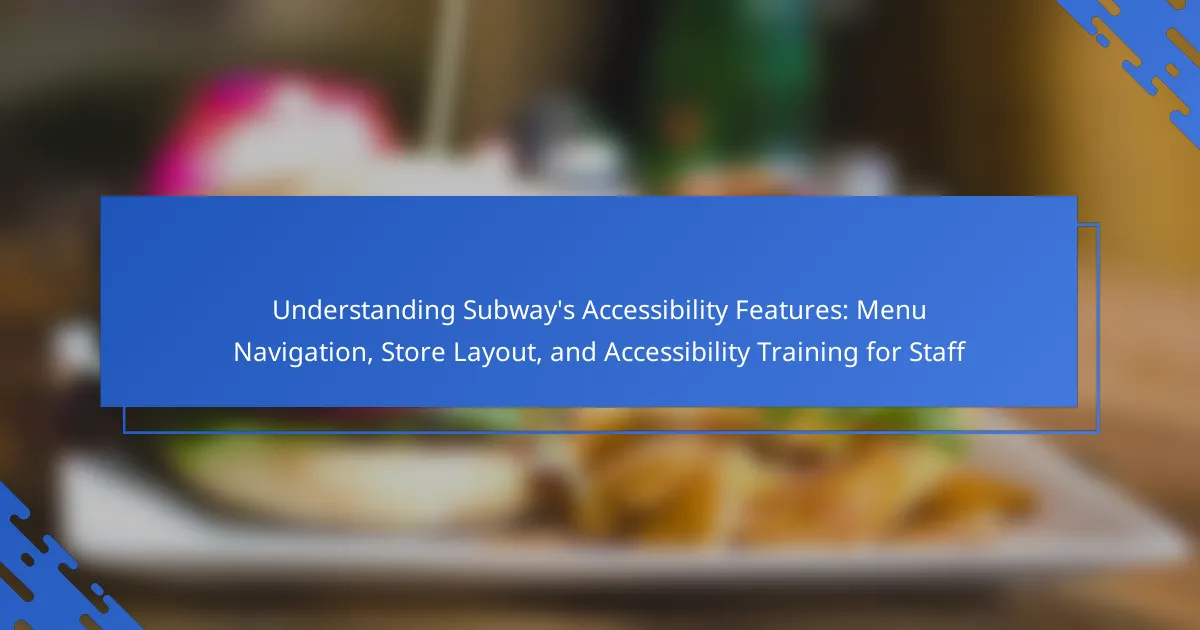Subway is a fast-food restaurant chain that prioritizes accessibility for individuals with disabilities. This article outlines Subway’s accessibility features, including wheelchair-accessible entrances, seating, and restrooms, as well as braille and large print menus for visually impaired customers. It also highlights the training provided to staff for assisting customers with disabilities and details the information available on Subway’s website regarding store accessibility. These initiatives reflect Subway’s commitment to inclusivity and adherence to the Americans with Disabilities Act (ADA).

What are Subway’s Accessibility Features?
Subway’s accessibility features include wheelchair-accessible entrances and seating, as well as accessible restrooms. Many Subway locations are designed to accommodate individuals with mobility challenges. The stores often provide menus in braille or large print for visually impaired customers. Staff members receive training on how to assist customers with disabilities effectively. Additionally, Subway’s website offers information on store accessibility. These features are part of Subway’s commitment to inclusivity and compliance with the Americans with Disabilities Act (ADA).
How does Subway ensure menu navigation is accessible?
Subway ensures menu navigation is accessible through clear signage and digital displays. The menus use large fonts and high-contrast colors for visibility. Subway locations often provide tactile elements for visually impaired customers. They also offer mobile ordering through their app, which enhances accessibility. Additionally, staff are trained to assist customers with navigation needs. This training includes understanding diverse customer requirements. Subway’s commitment to accessibility is reflected in their ongoing evaluations of store layouts and menu formats. These efforts align with industry standards for accessibility.
What tools or technologies are used for menu navigation?
Menu navigation tools and technologies include digital kiosks, mobile apps, and touchscreen interfaces. Digital kiosks allow customers to browse menus and place orders easily. Mobile apps provide a convenient way for users to access menu options from their devices. Touchscreen interfaces enhance user interaction by allowing direct selection. These technologies improve accessibility for all customers, including those with disabilities. Research indicates that such tools significantly enhance user experience and efficiency in fast-food environments.
How does the menu design cater to individuals with disabilities?
The menu design caters to individuals with disabilities by incorporating clear typography and high-contrast colors. This design choice enhances readability for those with visual impairments. Additionally, menus are available in multiple formats, including braille and large print. This ensures accessibility for individuals who are blind or have low vision. The layout is organized logically, making navigation intuitive for all customers. Symbols and images accompany text to aid understanding for those with cognitive disabilities. Feedback from disability advocacy groups has informed these design features. This commitment aligns with the Americans with Disabilities Act (ADA) standards for accessibility.
What is the significance of store layout in accessibility?
Store layout significantly impacts accessibility by facilitating movement and navigation for all customers. An effective layout minimizes obstacles and provides clear pathways. It ensures that essential areas, such as entrances and checkouts, are easily reachable. Research indicates that well-designed store layouts enhance the shopping experience for individuals with disabilities. According to the Americans with Disabilities Act, accessible design features improve usability for everyone. Proper signage and organization within the layout also aid in wayfinding. Overall, a thoughtful store layout promotes inclusivity and enhances customer satisfaction.
How does Subway’s store layout accommodate various disabilities?
Subway’s store layout accommodates various disabilities through accessible entrances and spacious aisles. Each store features automatic doors to assist individuals with mobility impairments. The aisles are designed to be wide enough for wheelchair access. Counter heights are adjustable to cater to different needs. Visual aids and clear signage assist customers with visual impairments. Additionally, staff are trained to provide assistance when needed. These features ensure that all customers can navigate the store comfortably.
What specific design elements enhance accessibility in Subway locations?
Wide doorways and aisles enhance accessibility in Subway locations. These design elements allow for easier navigation for individuals using wheelchairs or mobility aids. Additionally, tactile paving is often used to assist visually impaired customers. Clear signage with large print and high contrast helps all customers read information easily. Accessible seating areas are designed to accommodate wheelchairs comfortably. Staff training includes awareness of accessibility needs to assist customers effectively. These elements collectively ensure a more inclusive environment for all patrons.
How is accessibility training implemented for Subway staff?
Accessibility training for Subway staff is implemented through structured programs that focus on awareness and practical skills. The training includes modules on recognizing and assisting customers with disabilities. Staff learn about various disabilities and the specific needs of individuals. Role-playing scenarios are often used to simulate real-life situations. This hands-on approach helps staff practice their responses. Online resources and in-person workshops complement the training. Regular assessments ensure staff retain important information. Subway’s commitment to accessibility is reflected in their ongoing training efforts.
What topics are covered in Subway’s accessibility training programs?
Subway’s accessibility training programs cover various essential topics. These include understanding disabilities and their impact on customers. Staff are trained on effective communication techniques with individuals who have different accessibility needs. The programs emphasize the importance of creating an inclusive environment. Training also includes guidance on physical store layout adjustments to accommodate all customers. Staff learn about menu navigation aids available for those with visual impairments. Additionally, there is a focus on customer service best practices for assisting individuals with disabilities. Overall, the training aims to enhance the customer experience for everyone.
How does training impact staff interactions with customers requiring assistance?
Training significantly enhances staff interactions with customers requiring assistance. Well-trained staff can better understand customer needs and provide tailored support. Training equips employees with communication skills essential for effective engagement. It also fosters empathy, allowing staff to connect with customers on a personal level.
According to a study by the American Society for Training and Development, organizations that invest in training experience a 24% higher customer satisfaction rate. This indicates that trained employees are more capable of resolving issues efficiently. Additionally, training on accessibility features ensures staff can guide customers through menu navigation and store layout effectively.
Overall, training directly correlates with improved customer interactions and satisfaction levels.
How do Subway’s accessibility features benefit customers?
Subway’s accessibility features benefit customers by ensuring a more inclusive dining experience. These features include wheelchair-accessible entrances and counters. They allow individuals with mobility challenges to navigate the store easily. Additionally, clear signage helps customers with visual impairments. Menu navigation is simplified through large print options and digital displays. Staff training on accessibility ensures that employees can assist customers effectively. These measures enhance customer satisfaction and promote equal access to services. Studies show that inclusive environments lead to increased patronage and loyalty among diverse customer groups.
What feedback do customers provide regarding accessibility at Subway?
Customers provide mixed feedback regarding accessibility at Subway. Many appreciate the availability of wheelchair ramps and accessible seating. However, some report difficulties with store layouts that can be cramped. Customers have noted that certain locations lack clear signage for accessible features. Additionally, feedback indicates that staff training on assisting individuals with disabilities varies by location. Overall, while there are positive aspects, there are also areas needing improvement for better accessibility.
How does Subway measure the effectiveness of its accessibility features?
Subway measures the effectiveness of its accessibility features through customer feedback and performance metrics. They collect data from surveys and direct customer interactions. Subway also analyzes sales data to assess the impact of accessibility features on customer satisfaction. Regular audits of store layouts and accessibility training effectiveness are conducted. These evaluations help identify areas for improvement. Subway aims to enhance the overall experience for customers with disabilities. The company uses this information to adapt its strategies and implement necessary changes.
What challenges does Subway face in improving accessibility?
Subway faces several challenges in improving accessibility. One significant challenge is the variability in store layouts. Each location may have different physical configurations, impacting accessibility for individuals with mobility issues. Additionally, training staff on accessibility standards can be inconsistent across franchises. This inconsistency may lead to inadequate support for customers requiring assistance. Furthermore, the menu may not always accommodate diverse dietary needs, limiting options for those with specific requirements. Lastly, budget constraints can hinder the implementation of necessary renovations or technology upgrades for improved accessibility.
What are common barriers to implementing accessibility features?
Common barriers to implementing accessibility features include lack of funding, insufficient training, and outdated infrastructure. Funding limitations often prevent organizations from making necessary upgrades. Training staff on accessibility practices can be inadequate, leading to poor implementation. Outdated infrastructure may not support modern accessibility standards, complicating renovations. Additionally, there can be a lack of awareness about accessibility needs among decision-makers. These factors collectively hinder effective implementation of accessibility features.
How does Subway address these challenges over time?
Subway addresses accessibility challenges through continuous improvements in menu navigation, store layout, and staff training. The company regularly updates its menu to ensure clear labeling and easy navigation for customers with disabilities. Subway also modifies store layouts to create more open spaces for wheelchair access. Staff training programs include specific modules on assisting customers with various needs. These initiatives are informed by customer feedback and compliance with accessibility regulations. Subway’s commitment to inclusivity is evident in its ongoing assessments and adaptations of its services.
What best practices can Subway adopt for enhancing accessibility?
Subway can enhance accessibility by implementing clear signage and menu options. This helps customers with visual impairments navigate the store easily. Incorporating braille on menus and signage is essential. Providing audio assistance through mobile apps can further aid navigation. Staff training on accessibility needs is crucial for better customer service. Additionally, ensuring all store layouts are wheelchair-friendly supports physical accessibility. Regular audits on accessibility features can identify areas for improvement. These practices align with guidelines from the Americans with Disabilities Act (ADA), promoting inclusivity.
How can Subway leverage customer feedback for continuous improvement?
Subway can leverage customer feedback for continuous improvement by systematically collecting and analyzing customer insights. This can be achieved through surveys, comment cards, and social media engagement. Feedback should be categorized to identify common themes and issues. For example, if customers frequently mention difficulties in menu navigation, Subway can enhance its digital interfaces. Additionally, addressing concerns about store layout can lead to a more accessible environment. Implementing changes based on feedback demonstrates responsiveness and commitment to customer satisfaction. Research shows that brands that actively seek and act on customer feedback see a 10-15% increase in customer loyalty over time.
What innovative solutions can be explored to improve accessibility further?
Innovative solutions to improve accessibility further include implementing augmented reality (AR) for navigation. AR can provide real-time visual guidance to customers with disabilities. Additionally, voice-activated ordering systems can enhance the experience for those with mobility challenges.
Mobile apps that offer customizable accessibility features can help users tailor their experience. Integrating tactile maps and braille signage in-store can assist visually impaired customers. Regular staff training on accessibility can increase awareness and support for diverse needs.
Research indicates that enhancing accessibility can increase customer satisfaction and loyalty. A study by the American Institute of Architects found that accessible design boosts business by attracting a wider customer base.
Subway is the primary entity discussed in this article, focusing on its accessibility features, including menu navigation, store layout, and staff training. The article outlines Subway’s commitment to inclusivity through wheelchair-accessible entrances, braille menus, and staff training on assisting customers with disabilities. Key topics include the significance of store layout for accessibility, tools and technologies used for menu navigation, and the impact of staff training on customer interactions. Additionally, it addresses challenges Subway faces in enhancing accessibility and suggests best practices for continuous improvement.
